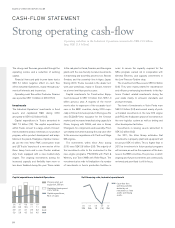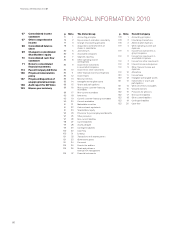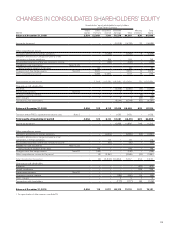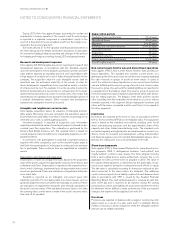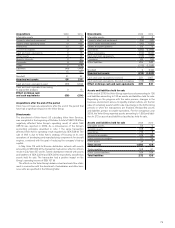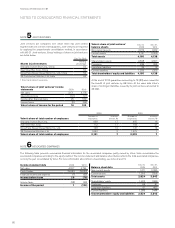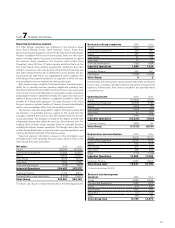Volvo 2010 Annual Report Download - page 75
Download and view the complete annual report
Please find page 75 of the 2010 Volvo annual report below. You can navigate through the pages in the report by either clicking on the pages listed below, or by using the keyword search tool below to find specific information within the annual report.
NOTES TO CONSOLIDATED FINANCIAL STATEMENTS
NOTE 1 ACCOUNTING PRINCIPLES
The consolidated financial statements for AB Volvo and its subsidiaries
have been prepared in accordance with International Financial Re porting
Standards (IFRS) issued by the International Accounting Standards
Board (IASB), as adopted by the EU. The portions of IFRS not adopted
by the EU have no material effect on this report. This Annual report is
prepared in accordance with IAS 1 Presentation of Financial State-
ments and in accordance with the Swedish Companies Act. In addition,
RFR 1 Supplementary Rules for Groups, has been applied, issued by
the Swedish Financial Reporting Board. Effective in 2005 Volvo has
applied International Financial Reporting Standards (IFRS) in its finan-
cial reporting. In accordance with the IFRS transitions rules in IFRS 1,
Volvo applies retrospective application from the IFRS transition date at
January 1, 2004. The details of the transition from Swedish GAAP to
IFRS are set out in Note 3 in the annual reports of 2005 and 2006.
Refer to the 2004 Annual Report for a description of the previous
Swedish accounting principles applied by Volvo.
In the preparation of these financial statements, the company man-
agement has made certain estimates and assumptions that affect the
value of assets and liabilities as well as contingent liabilities at the
balance sheet date. Reported amounts for income and expenses in
the reporting period are also affected. The actual future outcome of
certain transactions may differ from the estimated outcome when
these financial statements were issued. Any such differences will
affect the financial statements for future accounting periods. The key
sources of estimation uncertainty are set out in Note 2.
Consolidated financial statements
Principles for consolidation
The consolidated financial statements have been prepared in accord-
ance with the principles set forth in IAS 27, Consolidated and Separ-
ate Financial Statements. Accordingly, intra-Group transactions and
gains on transactions with associated companies are eliminated. The
consolidated financial statements comprise the Parent Company,
subsidiaries, joint ventures and associated companies.
– Subsidiaries are defined as companies in which Volvo holds more
than 50% of the voting rights or in which Volvo otherwise has a con-
trolling interest.
– Joint ventures are companies over which Volvo has joint control
together with one or more external parties. Joint ventures are reported
by use of the proportionate method of consolidation.
- Associated companies are companies in which Volvo has a sig-
nificant influence, which is normally when Volvo’s holdings equals to at
least 20% but less than 50% of the voting rights. Holdings in associ-
ated companies are reported in accordance with the equity method.
The Group’s share of reported income in such companies is included
in the consolidated income statement in Income from investments in
associated companies, reduced in appropriate cases by depreciation
of surplus values and the effect of applying different accounting prin-
ciples. Income from associated companies is included in operating
income as the Volvo investments are of operating nature. For practical
reasons, some of the associated companies are included in the con-
solidated accounts with a certain time lag, normally one quarter. Divi-
dends from associated companies are not included in consolidated
income. In the consolidated balance sheet, the book value of share-
holdings in associated companies is affected by Volvo’s share of the
company’s net income, reduced by depreciation of surplus values and
by the amount of dividends received.
Volvo applies IFRS 3 (revised), Business Combinations, for acquisi-
tions. Prior acquisitions are not restated. All business combinations
are accounted for in accordance with the purchase method. Volvo val-
ues acquired identifiable assets, tangible and intangible, and liabilities
at fair value. Surplus amount from purchase price, possible minority
Amounts in SEK M unless otherwise specified. The amounts within parentheses refer to the preceding year, 2009.
and fair value of previous possessions at the acquisition date com-
pared to the Group’s share of acquired net assets are reported as
goodwill. Any lesser amount, so-called negative goodwill, is reported
in the income statement.
At step acquisitions a business combination occurs only at the date
control is achieved, at the same time goodwill is calculated. Transac-
tions with the minority are reported as equity as long as control of the
subsidiary is retained. For each business combination Volvo chooses
if the minority should be valued either at fair value or at the minority’s
proportionate share of the acquiree’s net assets. All acquisition-
related costs are expensed. Companies acquired during the year are
consolidated as of the date of acquisition. Companies that have been
divested are included in the consolidated financial statements up to
and including the date of divestment.
Translation to Swedish kronor when consolidating
companies using foreign currencies
AB Volvo’s functional currency is the Swedish krona. All reporting in
group companies for group purposes is made in the currency, in which
the company has the majority of its revenues and expenses; normally
the currency of the country where the company is located. AB Volvo’s
and the Volvo Group’s presentation currency is Swedish kronor. In pre-
paring the consolidated financial statements, all items in the income
statements of foreign subsidiaries and joint ventures (except for sub-
sidiaries in highly inflationary economies) are translated to Swedish
kronor at monthly exchange rates. All balance sheet items are trans-
lated at exchange rates at the respective year-ends (closing rate). The
differences in consolidated shareholders’ equity, arising as a result of
variations between closing rates, for the current and previous year are
charged or credited directly to shareholders’ equity as a separate
component.
The accumulated translation difference related to a certain sub-
sidiary, joint venture or associated company is reversed to income as
a part of the gain/loss arising from the divestment or liquidation of
such a company.
IAS 29, Financial Reporting in Hyperinflationary Economies, is
applied to financial statements of subsidiaries operating in highly
inflationary economies. Volvo applies reporting based on historical
value. Translation differences due to inflation are charged against
earnings for the year. Currently, Volvo has no subsidiaries with a func-
tional currency that could be considered a hyperinflationary currency.
Receivables and liabilities in foreign currency
Receivables and liabilities in foreign currency are valued at closing
rates. Translation differences on operating assets and liabilities are rec-
ognized in operating income, while translation differences arising in
financial assets and liabilities are charged to other financial income and
expenses. Financial assets and liabilities are defined as items included
in the net financial position of the Volvo Group (see Definitions at the
end of this report). Derivative financial instruments used for hedging of
exchange and interest risks are reported at fair value. Gains on
exchange rates are reported as receivables and losses on exchange
rates are reported as liabilities. Depending on the lifetime of the finan-
cial instrument it is reported as current or non-current in the balance
sheet. Exchange rate differences on loans and other financial instru-
ments in foreign currency, which are used to hedge net assets in foreign
subsidiaries and associated companies, are offset against translation
differences in the shareholders’ equity of the respective companies.
Exchange rate gains and losses on payments during the year and on
the valuation of assets and liabilities in foreign currencies at year-end
are credited to, or charged against, income in the year they arise. The
more important exchange rates applied are shown in the table.
71





